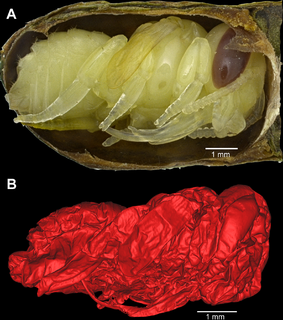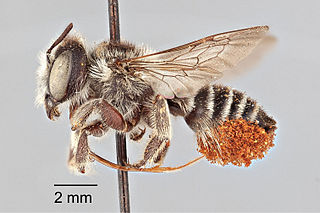
Megachile rotundata, the alfalfa leafcutting bee, is a European bee that has been introduced to various regions around the world. As a solitary bee species, it does not build colonies or store honey, but is a very efficient pollinator of alfalfa, carrots, other vegetables, and some fruits. Because of this, farmers often use M. rotundata as a pollination aid by distributing M. rotundata prepupae around their crops. Each female constructs and provisions her own nest, which is built in old trees or log tunnels. Being a leafcutter bee, these nests are lined with cut leaves. These bees feed on pollen and nectar and display sexual dimorphism. This species has been known to bite and sting, but it poses no overall danger unless it is threatened or harmed, and its sting has been described as half as painful as a honey bee's.

Megachilidae is a cosmopolitan family of mostly solitary bees. Both that their pollen-carrying structure is restricted to the ventral surface of the abdomen, and their typically elongated labrum is characteristic of this family. Megachilid genera are most commonly known as mason bees and leafcutter bees, reflecting the materials from which they build their nest cells ; a few collect plant or animal hairs and fibers, and are called carder bees, while others use plant resins in nest construction and are correspondingly called resin bees. All species feed on nectar and pollen, but a few are kleptoparasites, feeding on pollen collected by other megachilid bees. Parasitic species do not possess scopae. The motion of Megachilidae in the reproductive structures of flowers is energetic and swimming-like; this agitation releases large amounts of pollen.

Megachile pluto, also known as Wallace's giant bee or raja ofu, is a large Indonesian resin bee. With a wingspan of 63.5 mm (2.5 in) it is the largest known living bee species. It was believed to be extinct until several specimens were discovered in 1981. No further sightings were confirmed until two specimens were collected and sold on eBay in 2018. A live female was found and filmed for the first time in 2019.

The genus Megachile is a cosmopolitan group of solitary bees, often called leafcutter bees or leafcutting bees; it also includes the called resin bees and mortar bees. While other genera within the family Megachilidae may chew leaves or petals into fragments to build their nests, certain species within Megachile neatly cut pieces of leaves or petals, hence their common name. This is one of the largest genera of bees, with more than 1500 species in over 50 subgenera. The alfalfa leafcutter bee is managed on a commercial scale for crop pollination, and has been introduced by humans to various regions around the world.

Megachile sculpturalis, known as the giant resin bee and sculptured resin bee, is a species of leafcutting bees belonging to the family Megachilidae.

Megachile campanulae, known as the bellflower resin bee, is a species of bee in the family Megachilidae. Described in 1903, these solitary bees are native to eastern North America. Studies in 2013 placed them among the first insect species to use synthetic materials for making nests. They are considered mason bees, which is a common descriptor of bees in several families, including Megachilidae. Within the genus Megachile, frequently also referred to as leafcutter bees, M. campanulae is a member of the subgenus Chelostomoides, which do not construct nests from cut leaves, but rather from plant resins and other materials. Females lay eggs in nests constructed with individual cell compartments for each egg. Once hatched, the eggs progress through larval stages and subsequently will overwinter as pupae. The bees are susceptible to parasitism from several other bee species, which act as brood parasites. They are medium-sized bees and the female adults are typically larger than the males. They are important pollinators of numerous native plant species throughout their range.
Megachile angelarum is a species of bee in the Megachilidae family.

Megachile aurifrons is a species of bee in the family Megachilidae. It was described by Frederick Smith in 1853.

Coelioxys sodalis is a bee from the family Megachilidae, one of numerous kleptoparasitic bees in the tribe Megachilini. Members of the genus Coelioxys exhibit kleptoparasitic behavior in that they lay their eggs in the nests of other bees, typically those of the related genus Megachile. As this behavior is similar to that of cuckoos, such bees are referred to as cuckoo bees. These host-parasite relationships are complex Host insects of the brood parasite C. sodalis include Megachile melanophaea, M. texana, and M. rotundata.

Megachile gentilis is a species of bee in the family Megachilidae. It was described by Cresson in 1872.
Megachile illustris is a species of bee in the family Megachilidae. It was described by T B Mitchell in 1930.
Megachile imitata is a species of bee in the family Megachilidae. It was described by Smith in 1853.

Megachile policaris is a species of bee in the family Megachilidae. It was described by Thomas Say in 1831.

Megachile rubi is a species of leaf cutting bee in the family Megachilidae, found in the eastern United States. First described by Mitchell in 1924, it is placed in the subgenus Xeromegachile, members of which are most often found in sandy areas and have distinct preferences in the petals and leaves they use in their nests.
Megachile simonyi is a species of bee in the family Megachilidae. It was described by Heinrich Friese in 1903.

Megachile texana, the Texas leafcutter bee, is a species of bee in the family Megachilidae. It was first described by the American entomologist Ezra Townsend Cresson in 1878. It is native to the United States and southern Canada.

Megachile maritima, common name coast leaf-cutter, is a species of leaf-cutter bees in the family Megachilidae. It was described by William Kirby in 1802.

Megachile oenotherae is a species of bee in the family Megachilidae. It was described by Mitchell in 1924.
Megachile umatillensis is a species of bee in the family Megachilidae. It was described by Mitchell in 1927.

Megachile (Megachiloides) chomskyi is a species of leafcutter bee found in Texas. It is in the oenotherae species group. It is likely a specialist pollinator of plants in the family Onagraceae. Cory S. Sheffield described the species in 2013 and named the specific name in honor of Noam Chomsky.















